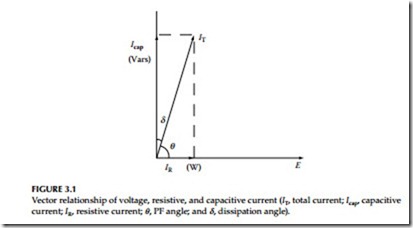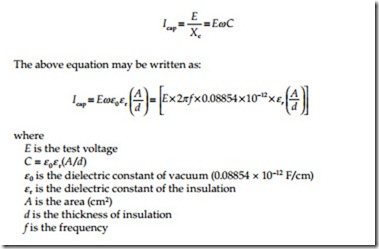Introduction
This chapter covers the power factor (PF) and dissipation factor (DF) tests that are ordinarily conducted in the field for acceptance (start-up) and routine field (maintenance) testing of insulation of electrical equipment and appara- tus. The PF and DF tests are conducted using the 60 Hz power frequency voltages, therefore these tests may be referred to as alternating current (AC) voltage tests. The purpose of conducting these tests is to identify if the equip- ment has been installed properly, determine if corrective maintenance and repair is needed, and/or track the gradual deterioration of the equipment over its life. The question might be asked, why conduct these tests? The answer is obvious because the equipment to be tested is normally energized with 60 Hz AC voltage, therefore testing with the same type of voltage that the equipment sees in service provides the best information on the condition of that equipment. By applying an AC voltage test potential across a series of insulations (insulation system), the voltage drop across each layer of insula- tion and the resulting measured losses can be equated to true operating con- ditions. The voltage drop is proportional to the dielectric constant of the insulation layers. There are other AC voltage tests that may be performed along with PF and DF tests. The AC voltage tests can be classified into the categories as listed below:
1. PF and DF
2. AC high potential tests
3. Very low frequency (VLF)
4. AC series resonant
5. Induced frequency
6. Partial discharge (PD)
7. Impulse tests
The AC tests may be classified as destructive and nondestructive tests. The PF and DF tests are considered nondestructive since the test voltages used in performing these tests do not exceed line-to-neutral voltages of the equipment being tested. The basic principle of the nondestructive testing is the detection of a change in the measurable characteristics of an insulation that can be associ- ated with the effects of contaminants and destructive agents without over- stressing the insulation. The AC high potential, VLF, and AC series resonant tests may be classified as destructive since the test voltages associated with these tests are higher than normal operating voltages which may overstress the insulation. The effect of repeated high voltage (HV) tests on insulation are cumulative and therefore thoughtful consideration should be given on the ben- efits of these tests for routine field and maintenance testing, except for special investigations or for acceptance testing. The induced frequency, PD, and impulse tests are primarily conducted at the factory during manufacturing of electrical apparatus and equipment. However, for special investigations these tests may be performed in the field but will require special test equipment and setup. The AC high potential, AC series resonant, VLF, PD, induced frequency, and impulse tests are covered in other chapters under respective equipment category. This chapter is exclusively devoted to PF and DF testing methods.
PF and DF Test Methods General
The PF insulation tests were used in the laboratory since the early 1900s by cable manufactures, and in the field for testing bushing since 1929. The DF is based on the Schering bridge which was developed also in the early 1900s to evaluate insulation by separating the capacitive and real components of the charging current. Today, the PF and DF tests are considered to be synony- mous because they both refer to the AC dielectric loss test. PF and DF are but two of the several measurable characteristics that can be obtained from an AC dielectric loss test used for evaluating the condition of the insulation system. Both of these tests are effective in locating weaknesses in the electri- cal insulation and hazard in the power apparatus before impending failure. PF and DF tests are not go-no-go tests, and can measure dielectric loss, capac- itance, and AC resistance of the insulation of the electrical apparatus. These tests can measure the presence of bad insulation even when there may be a layer of good insulation in series with the bad insulation. These tests pro- vide information on the overall condition of the insulation in terms of a ratio (i.e., PF or DF value of insulation) that is independent of the volume of the insulation being tested. Moreover, they provide assessment of the insulation under normal frequency (60 Hz) operating conditions which is not time dependent like the direct current (DC) voltage tests. The PF and DF tests do not overstress the insulation and can determine if the insulation is slowly degrading by comparison with previous year’s test results, or with test results of similar equipment.
Principles of PF/DF Testing
The PF/DF tests measure insulation capacitance, AC dielectric losses, and the ratio of the measured quantities. When insulation is energized with an AC voltage, the insulation draws a charging current. This charging cur- rent comprises of two components called capacitive current and resistive current. The capacitive current leads the applied test voltage by 90°, whereas the resistive current is in phase with the voltage as shown in Figure 3.1. The capacitive current is directly proportional to the dielectric constant, area, and voltage and inversely proportional to the thickness of the insulation under test. The capacitive current may calculated by the following formula:
Changes in the capacitive current indicate degradation in the insulation, such as wetness or shorted layers, or change in the geometry of the insulation. The resistive current supplies the energy lost due to dielectric losses such as carbon tracking, volumetric leakage, surface conduction, and corona. Dielectric losses due to water contamination or carbon tracking or other forms of deterioration increase by the square of the voltage, where as dielec- tric losses due to corona increase exponentially as the voltage increases. PF/DF testing is sensitive enough to detect a deteriorated moisture problem in the insulation compared to an insulation resistance test.
Although there are several manufacturers of PF/DF test equipment, this text describes PF test methods and procedures based on the PF test equip- ment of Megger Incorporated (originally Megger Instruments), Valley Forge, Pennsylvania and Doble Engineering Company, Watertown, Massachusetts. The PF methods, theory, and principles discussed in this text are also applicable to the PF test equipment of other manufactures. It should be noted that in the electrical industry, especially in the utility transmission and dis- tribution (T&D) arena, the PF test may be referred to as Doble test* because of the use of the Doble test sets when performing PF tests. The terms PF test and Doble test are one and the same.
Factors That Influence PF Measurements
The PF measurement is a searching diagnostic tool for evaluating insulation condition. It is a fundamental concept that changes in insulation quality result in measurable changes in some of the basic electrical characteristics of the insulation, such as capacitance, dielectric loss, or PF. Therefore, by mea- suring these electrical characteristics over time, changes in the integrity of the insulation can be assessed. Unfortunately, PF tests cannot always be con- ducted under the desired or same conditions because the equipment may be located outdoors or the environment may be different from test to test. There are two environmental variables which cannot be controlled easily; they are temperature and humidity. Also, depending on the cleanliness of the insula- tion and relative humidity, surface leakage current can also have an effect on the PF measurements. The electrical characteristics of most insulation materi- als vary with temperature. In order to compare the results of routine PF tests measurements taken at different temperatures for the same equipment, it is necessary to normalize the results to a common base temperature. It is a rec- ommended practice to convert the measured PF values to a common base temperature of 20°C. When equipment is tested near freezing temperatures where a large correction factor may cause the resultant PF to be unacceptably high, then the equipment should be retested at a higher temperature before the equipment is condemned. Similarly, when high PF results are encountered at high temperature, the equipment should be retested after it has been allowed to cool down. Also, PF tests should not be performed for detection of presence of moisture in the insulation when the temperatures are much below freezing, because the ice has a resistivity of approximately 144 times that of water. Although, the temperature correction factors have been developed for correcting the measured PF results to a common base temperature, no such factors are available for humidity effects because of other variable effects. One of variables that affects the insulation measurement is surface leakage, which is dependent upon the moisture and the cleanliness of the surface of the specimen under test. When making PF tests, the effects of surface leakage (due to humidity, dirt, etc.) should be recognized and addressed accordingly. The effects of surface leakage current may be minimized by cleaning and drying external surfaces to reduce the losses, or using guard collars to divert the surface leakage current from the measuring circuit, or using the combina- tion of the two approaches. Some cases may be handled quite easily with no thought or effort as to control of surface leakage, while others may require an extra effort to produce good results. It should also be recognized that there will be times when it will be best to postpone tests until another day. Refer to Section 3.7 for further discussion of variables affecting PF measurements.
The PF test results may be converted to the reference temperature of 20°C (68°F) using the conversion factors given in the test manual. The procedure for normalizing the test results to 20°C consists of (1) determine the test specimen PF, (2) measure the test specimen temperature, (3) obtain the appropriate correc- tion factor from the table corresponding to the specimen temperature, and (4) multiply the calculated PF value with the correction factor.

